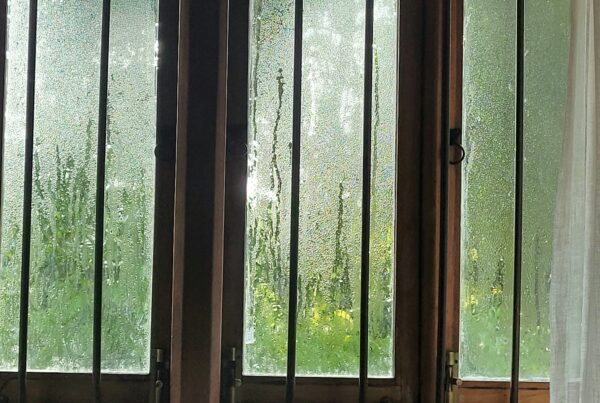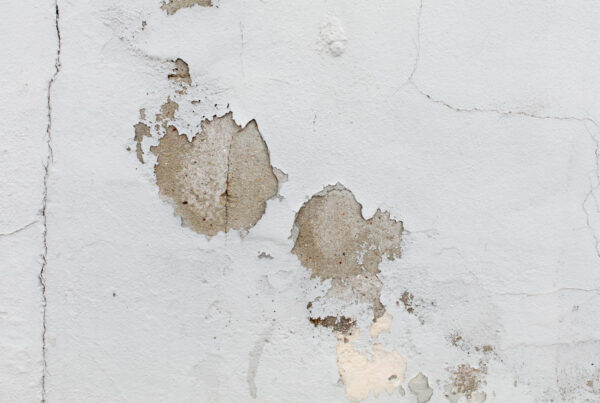Waking up to streaming windows and damp patches in room corners is a common household problem affecting countless UK homes. Wall condensation creates uncomfortable living conditions and can lead to serious mould growth if ignored. Learning to prevent condensation on walls helps protect people’s health and preserves your property’s condition.
This article will help you understand the three essential steps to stop condensation from forming on walls, discover practical moisture prevention techniques, and create a comfortable, dry home environment.
What Causes Condensation on Walls?
Condensation occurs when warm, moist air meets cold surfaces, causing water vapour to turn back into liquid droplets. Think of a cold drink can on a warm day – the water droplets come from the surrounding air moisture, not from inside the can.
Wall condensation happens due to three factors: excess moisture in your home’s air, poor ventilation that traps humid air, and cold wall surfaces that provide ideal conditions for water vapour to condense.
Modern homes with improved insulation but inadequate ventilation frequently experience wall condensation problems. Daily activities like cooking, showering, and drying clothes release water vapour that accumulates on cold surfaces when suitable air circulation is absent.
How Can You Reduce the Occurrence of Moisture at the Source?
Controlling moisture at its source is an effective approach to preventing condensation on walls. Every day, household activities produce surprising amounts of water vapour, which contributes to humidity levels.
Kitchen Moisture Control Techniques
Cooking activities generate steam and water vapour that must be controlled to prevent wall condensation throughout your home:
- Cover cooking pots and pans – This helps reduce steam release into your kitchen’s atmosphere during meal preparation
- Use extractor fans consistently – Run kitchen extraction during cooking and continue for 15 minutes afterwards to remove cooking vapours
- Check for appliance leaks – Inspect dishwashers, washing machines, and pipes regularly to prevent hidden moisture sources
- Maintain consistent temperatures – Sudden temperature changes increase the risk of condensation, so keep kitchen heating steady
Bathroom Moisture Management
Bathrooms produce the highest humidity levels in most homes, making effective moisture control key for preventing condensation problems:
- Run extractor fans properly – Use bathroom extraction during every shower or bath and continue running for 20 minutes after finishing
- Keep bathroom doors closed – Contain steam within the bathroom to prevent humid air from spreading throughout your home
- Wipe down wet surfaces – Use a squeegee or towel to remove water from shower screens, tiles, and surfaces after use
- Fix plumbing leaks promptly – Address dripping taps, loose joints, or faulty seals that contribute to ongoing moisture problems
Properties experiencing persistent humidity problems may benefit from professional assessment to identify all moisture sources.
What Ventilation Improvements Help Prevent Wall Condensation?
Effective ventilation removes moisture-laden air and replaces it with drier external air, creating the circulation needed to prevent condensation problems. Natural ventilation improvements offer cost-effective solutions that work immediately. We recommend opening windows on opposite sides of your home for 10-15 minutes each morning to create cross-ventilation that exchanges damp indoor air with drier outdoor air.
Keep window trickle vents open continuously as these small openings provide constant background air exchange without creating draughts. External air bricks must remain unblocked by furniture, storage items, or overgrown vegetation, as these ventilation points allow for air circulation and help prevent ground-level moisture accumulation.
Improve air circulation around furniture by leaving gaps of several inches between wardrobes, sofas, and external walls to prevent stagnant air pockets that create cold spots where condensation readily forms. Our condensation solutions help UK homeowners improve air circulation to remove wall condensation problems.
How Do You Keep Wall Surfaces Warm to Prevent Condensation?
Maintaining warm wall surfaces prevents the formation of condensation by keeping surface temperatures above the dew point where water vapour condenses.
Effective wall warming strategies include:
- Keep consistent heating levels – Keep your home at steady, moderate temperatures instead of using short bursts of high heat.
- Improve loft insulation – Heat rises, making roof space insulation a cost-effective way to keep your home warmer.
- Install cavity wall insulation – Properties with cavity walls benefit greatly from professional insulation that keeps external walls warmer.
- Consider internal wall insulation – Solid wall properties may need internal insulation boards to prevent thermal bridging.
- Upgrade window glazing – Double or triple glazing keeps glass surfaces warmer and reduces window condensation.
Thermal bridging occurs when cold spots develop on walls due to inadequate insulation. These cold areas become prime locations for condensation formation and require targeted insulation improvements.
What Should You Do About Existing Mould Growth?
Existing mould growth requires safe removal before implementing prevention measures, as black mould produces health risks and indicates serious moisture problems. For extensive mould issues, Refresh provides professional assessment and safe removal services.
Wear rubber gloves, eye protection, and face masks to prevent spore inhalation. Never clean large, mouldy areas (over 1 square metre) yourself, as this releases dangerous spore quantities.
Then create a cleaning solution using equal parts white vinegar and water in a spray bottle. Avoid bleach, as it whitens mould without killing roots and can release harmful fumes. Apply the solution to affected areas, leave for 15-20 minutes, and then wipe with disposable cloths. Avoid dry scrubbing and dispose of contaminated materials immediately.
Once the solution’s been used, consider anti-mould paint containing fungicides to prevent regrowth. Professional moisture control specialists can identify underlying dampness causes that enable mould growth.
When Should You Contact the Specialists?
Professional assessment becomes necessary when DIY condensation prevention methods fail to resolve persistent problems or when underlying structural issues contribute to moisture problems. Contact specialists like Refresh Property Services if condensation appears widespread throughout your home, returns quickly after cleaning, or accompanies other dampness signs like musty odours or structural damage.
One thing we particularly specialise in is basement waterproofing in London, which can be a great way of preventing rising damp and other issues leading to moisture issues in your home. For professional condensation and waterproofing treatments, call Refresh PSC today.
Create a Condensation-Free Home with From Refresh
We can distinguish between condensation issues and structural dampness problems. Our proven expertise in moisture control helps UK property owners resolve complex condensation problems. Our treatment solutions combine practical moisture management advice with professional assessment to create lasting results. Contact us for a professional condensation assessment and expert prevention strategies.



